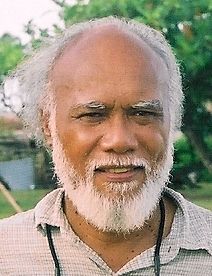Father and son published their first bilingual book of an old Tongan fable Featured

16 September, 2020. After four years of drafting, translating and production, a father and son's combined efforts has come to fruition with their first bilingual book of an old Tongan fable.
'Ko Kumā Mo Feke' or 'The Mouse and the Octopus' is an origin story that follows a mischievous mouse and an oblivious octopus.
The story is a parable to teach fishing lure design and exemplifies the knowledge contained within island communities.
It's a children's book that shows how the environment sustains, fostering an appreciation for the Pacific's unique ecosystem and the need for its preservation.
Author and illustrator, Lisala Halapua had published a few books already, which he called the "Island Fables series", but this one was written in both Tongan and English.
"All my books share the same characteristic - they are pamphlets that explain a different way in which humans can accommodate themselves into the ecosystem found on the Tongan archipelago, so that both can prosper," the author said.
He said the underlying message focused on the Tongan ecosystem and the watercolour illustrations were all referenced from actual places in Tonga.
"Ko Kumā Mo Feke's illustrations are based off northwest Tongatapu during a particularly severe dry season. Also, since Tonga is so central to these stories it was logical that they would be in Tongan."
Lisala Halapua
It was not a straightforward process for Halapua, as he was unable to find a publishing company that would pick up his project.
"We decided to form the publishing company Talanoa Books from the ground up and we learnt the hard way in terms of production to distribution, that's why it took four years to get this book up," he said.
Halapua shared this achievement with his father, Dr. Sitiveni Halapua, who worked on the translation.
"It wasn't transliteration, but translation that my dad worked on, which mean he spent about a year on it until he was satisfied with the results.

Dr. Sitiveni Halapua
Ko Kumā Mo Feke was originally planned to be an exclusively Tongan language version, but Halapua explained that teachers from Tonga gave him feedback that would change the course.
"I consulted with teachers from my homeland who wanted me to include both English and Tongan after they expressed a desire for the book to be an educational tool for English language acquisition.
"From the very beginning, I knew these stories were always going to be bilingual, but that feedback helped give me perspective," he said.
As the illustrator, Halapua shared that before writing the story, the look of the book had to be established such as how many pages it will have, the dimensions of the cover, what materials will be used.
"One aspect that determines how the book looks is the font, and for the font our number one requirement was that it needed to be able to serve the Tongan alphabet, in particular, toloi [macron] and *fakauʻa.
"Not all fonts display macrons and glottal stops legibly or aesthetically and so it was with these requirements that we chose one to be used in both versions to create uniformity, which was important from a design perspective."
Halapua hoped to see more bilingual books of different genres published soon.
"From what has been told to us by bookshops, the demand for Tongan bilingual children's books far exceeds the supply - something to think about for anyone who is interested in creating their own," he said.
*an apostrophe that comes before a vowel sound. This changes the vowel to a shorter, sharper sound. This also distinguishes between different words, for example, anga (behaviour) and 'anga (shark).
- RNZI



